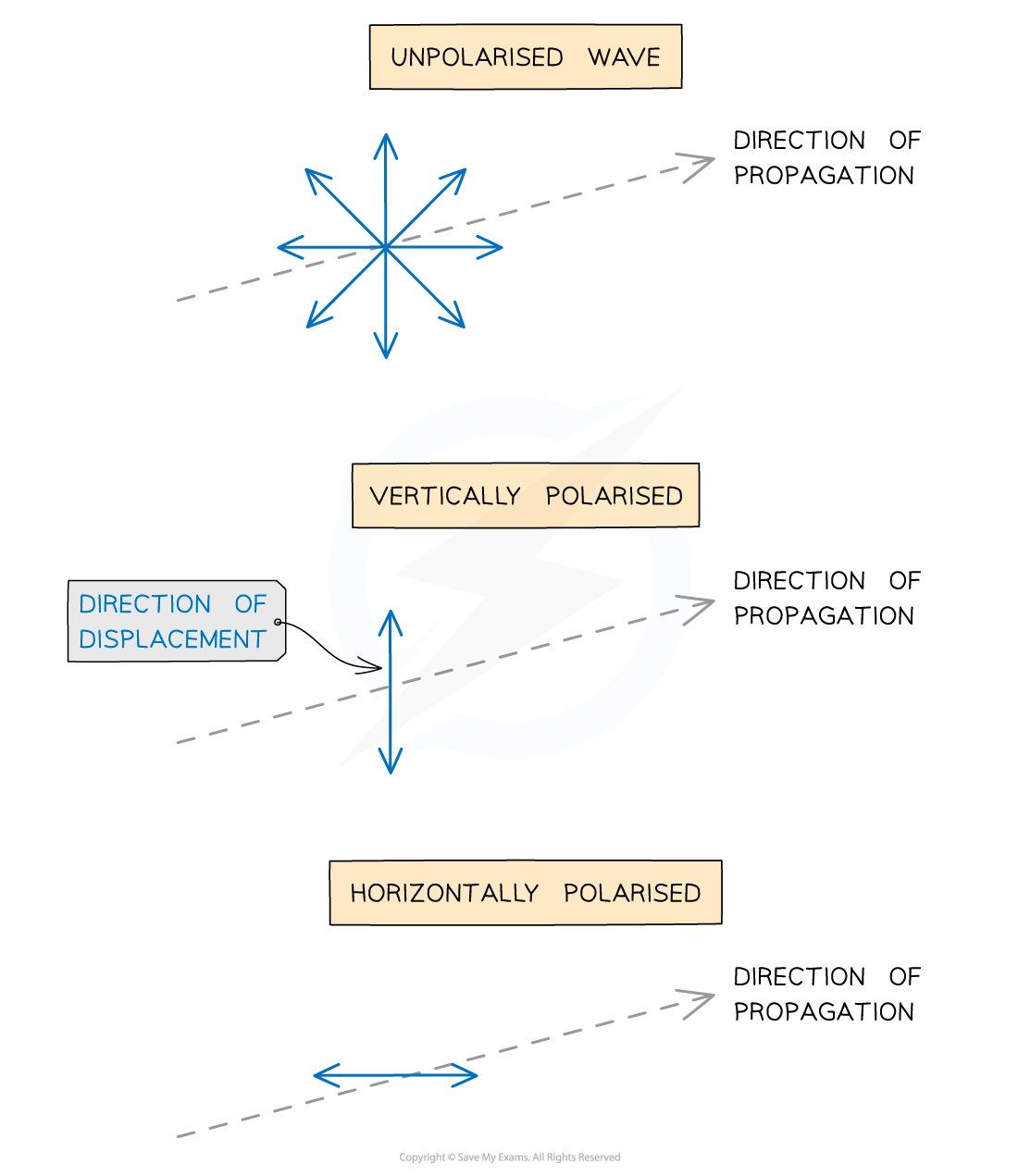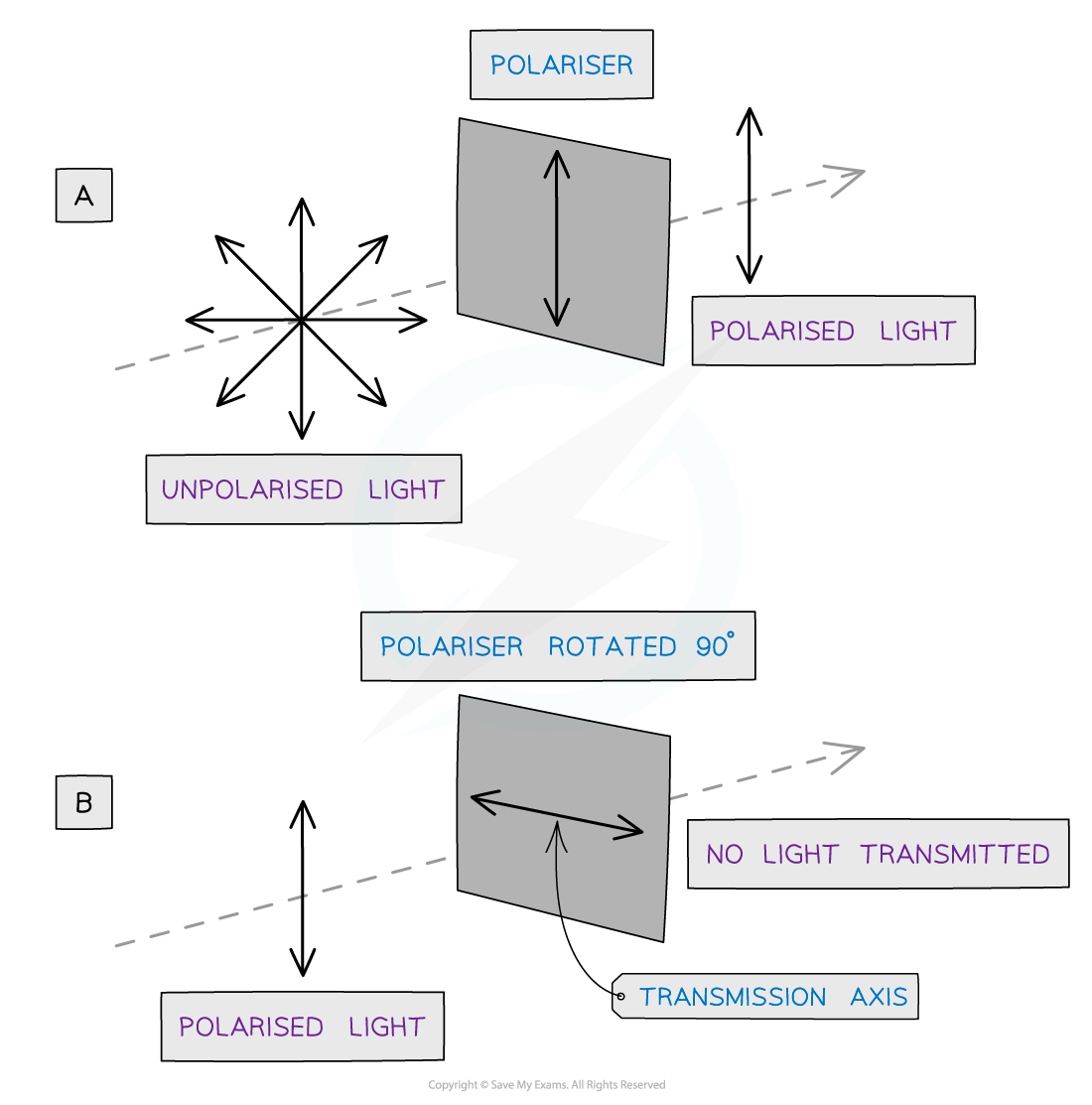Plane Polarisation (Edexcel International A Level (IAL) Physics): Revision Note
Exam code: YPH11
Plane Polarisation
Transverse waves can oscillate in any plane perpendicular to the direction of motion (and energy transfer) of the wave
Such waves are said to be unpolarised
When a wave is plane polarised:
Particle oscillations occur in a single plane perpendicular to the direction of wave propagation
Polarisation can only occur in transverse waves
This is because transverse waves oscillate in any plane perpendicular to the propagation direction

Diagram showing the displacement of unpolarised and polarised transverse waves
Since longitudinal waves oscillate in the same direction as the direction of motion of the wave, polarisation of longitudinal waves cannot occur
Methods of polarisation include
polarising filters
reflection (from a non-metallic plane surface)
refraction
Polarising filters
Light waves can be polarised by making them pass through a polarising filter (also known as a polariser)
The filter imposes its plane of polarisation on the incident light wave
A polariser with a vertical transmission axis only allows vertical oscillations to be transmitted through the filter (A)
If vertically polarised light is incident on a filter with a horizontal transmission axis, no transmission occurs (B), and the wave is blocked completely

Diagram showing an unpolarised and polarised wave travelling through polarisers
Polarisation by reflection
When light is reflected from a non-metallic surface e.g. the surface of water or a wet road, it undergoes partial plane polarisation
Reflected light is polarised in a plane parallel to the reflecting surface
This means if the surface is horizontal, a proportion of the reflected light will oscillate more in the horizontal plane than in the vertical plane
Sunglasses with vertically aligned Polaroid lenses can block this horizontally polarised light
As a result, they can reduce glare, which means
objects under the surface of water can be viewed more clearly
drivers can see the road more clearly

When sunlight reflects off a horizontal reflective surface, such as water, the light becomes horizontally polarised. This is where Polaroid sunglasses come in useful with their vertically aligned polarising filters
Polarisation by refraction
Light can also become partially polarised by refraction when transmitted from one medium into another, such as from air into glass or water
Refracted light is polarised in a plane perpendicular to the transmitting surface
This means if the surface is horizontal, a proportion of the transmitted (refracted) light will oscillate more in the vertical plane than in the horizontal plane
When unpolarised light is incident on a horizontal surface into which it can refract:
some of the light is reflected, partially polarising it in the horizontal plane
some of the beam is transmitted and refracted, also partially polarising it, but in the vertical plane

Unpolarised light can be partially polarised by both reflection and refraction at the boundary between two media, such as air and glass
Using polarisation for stress analysis
Polarising filters can be used to observe stress concentrations in materials due to changes in refractive index
A sample of transparent material (such as plastic) is positioned between two polarising filters with their planes at 90° to one another
When the material is unstressed, no light passes through
When the material is stressed, the plane of polarisation of the light passing through the material is rotated
Different areas under different degrees of stress cause light to pass through at different speeds
The result is an interference pattern with different colours revealing areas of varying stress in the material
The brighter regions represent areas under more stress
The darker regions represent areas under less stress
Using polarisation for chemical analysis
Polarising filters can also be used to analyse the strength of chemical samples, such as sugar solutions
In a similar way to materials under stress, chemical solutions can also rotate the plane of polarisation of the light passing through
The degree of polarisation depends on the concentration of the solution
The higher the concentration of the sample, the greater the angle at which the light emerges
The lower the concentration of the sample, the smaller the angle at which the light emerges

Unlock more, it's free!
Did this page help you?